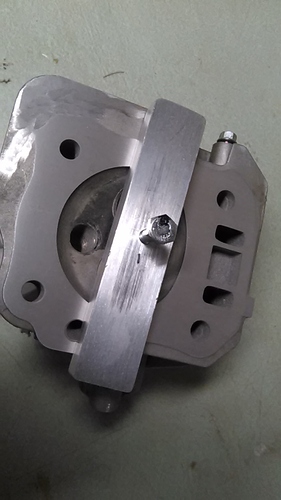I spend a lot of time getting these engines to put out more than 6 hp
Basic tuning and removing the restrictive exhaust and air filter can add 2 hp around 4500 rpm.
This is way more RPM than we can manage with wood gas I fear.
But the same tricks still apply.
All the restrictions that can be removed should, the engine must be able to breath to compensate for the lower BTU rating of the fuel.
The gasifier IS the biggest restriction and it can not be helped.
But a good welded exhaust made from pipe with 3/4 inch ID will make a difference as will a large free flowing muffler off a small car.
The pipe should have as few bends as possible and be about 2 feet long to the mufler.
Inside the head’s ports there are some rough edges, it would not hurt to knock these off so nothing feels sharp inside.
Lash for factory setting is .003, but I prefer to set it to zero after the valves have been lapped in head ( this engine makes lash when it warms up it will not tighten )
Timing should be advanced to 25 Before TDC for GX200 as a starting point and 30 for a GX160.
This is based on a gut feeling.
ALL new Honda T2 engines us a Modified CDI ignition I will get a part number for this later.
Where possible on a rebuild use the Z4M Honda piston in a GX200 block ( this piston was designed for the T1 Gx160 but it fits the 200 )
Any GX160 head will fit the 200 but I would prefer the 14cc heads used on Chinese engines or the older Honda 160
Look very close at this head and see the shape of the chamber and the dark patch of carbon around the edge.
This style of head has what is called a quench and when combined with the Z4M will make for very good mixing and it will speed up the burn time in the engine.
It will also raise the compression to 11.5:1 or there abouts depending on tolerances and gaskets used.
Done too the full conclusion of my suggested build I suspect this engine may recover 10% or 20% of its lost power.
Maybe it could pull 5 hp.
More important it will make maximum use of its fuel.
At wide open throttle it will not run hot, not exceed its design limits and the cylinder pressure should not harm the rod bearing ( should not is not the same as I know for a fact ).
At wide open throttle its pumping losses will be the lowest too and with the compression and timing advanced it will be real close to what I think the area for best thermal efficiency is.
But I am guessing based on race engines.
I never built this engine.
As I type this I am confronted with the unfortunate passing my beloved 1971 Ariens snow blow that already has a high compression engine on it.
It may well see the light of day as prototype gas clone this summer unless some mystical and magical happens that lands me hundreds of dollars worth of parts for a Ariens 910006 series tractor.
The grieving continues…
But I do have that head and still have an older flat top piston could add to old smoky to run some real world tests




